Terry Catalano moves one of his 50-pound found-wood sculptures across his Pearl Street apartment’s sunroom to make space for a six-foot Christmas tree, decorated with a collection of toys from the swap shop at the Provincetown dump. “A salute to the Land of Misfit Toys,” he says.
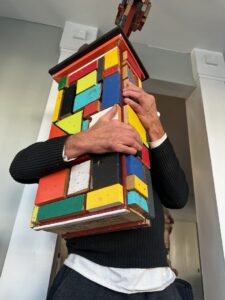
The sculpture, Untitled #3, is an assemblage of colorful but faded blocks nailed into the sides of two three-foot-long red panels. Two intricate flowers rise out of a rectangular wooden box; their red stems are made from the weathered maroon arms of an abandoned Adirondack chair, and their center stigmas are gold beer bottle caps.
“This thing is so heavy — it’s solid,” Catalano says. He picks up the piece and holds it proudly to his chest. “I didn’t want it to be flimsy. I wanted it to last longer than me.”
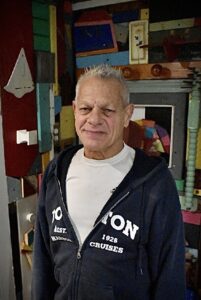
A similar piece sold at his April show at Spiritus, the Commercial Street pizza shop that features local artists’ work. Catalano has had the first show of the season at Spiritus each spring since 2018.
“Couple hundred bucks to buy it,” he says. Catalano keeps his prices low. He knows workers haven’t had time to earn money for art at his early season show. But the funky works attract attention for their colors and for the meticulous placement of each piece of scrap wood.
Four layers of polyurethane seal his sculptures. “There goes my green effect,” he says. Catalano doesn’t use paint or new pieces of wood in his work. Aside from cutting the wood, he assembles all the materials as found.
In the 1990s, when he first arrived in Provincetown from Los Angeles — “a true valley boy” — Catalano wrote poetry and “nothing happened,” he says. Then he wrote short stories and again nothing happened. He wrote a play, 24 hours, that was produced at the Unitarian church, directed by the late Bob Seaver. But he knew, he says, “there was no future in that.” Meanwhile, he tended bar.
One entrepreneurial experiment did take off. In 1999, Catalano started a consignment art auction business, which he ran for 15 years. During that time, on a trip to Paris, he found himself collecting images of graffiti. He came home with over 600 photographs of graffiti tags, decals, and remnants, which he cut up and framed.
In 2014 the short-lived Provincetown Public Press published Catalano’s e-book, Love on the Beat, a photographic journey into collective graffiti. The press was a project of the Provincetown library, where then-director Matt Clark allowed Catalano to create a collective graffiti installation he called Love on the Lawn.
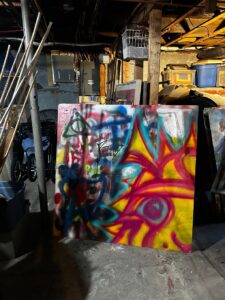
Using sheets of plywood, Catalano created two temporary walls — something he got good at by hanging art for his auction exhibitions — each 40 feet long, one on either side of the library’s lawn, and invited the public to tag the walls. He photographed sections for printing and framing before inviting professional artists to come “bomb” (paint over) the existing marks.
“Within those walls there are voices that want and need to be heard,” says Catalano, pointing to a dozen energetic pieces stacked on his basement floor.
At about the same time he started his auction house project, he was walking the beach in Provincetown when he saw three pieces of wood that had washed ashore. “These are cool,” he thought. He took them home and nailed them together. Bob Seaver bought the piece for $250, Catalano says, “so I did the same thing the next day.” That piece sold, too, and his creative practice was underway.
A spiral staircase leads from Catalano’s living room to his basement studio, where one wall is covered with sawed-off shapes of colorful found wood, meticulously pieced together. It is a work of art.
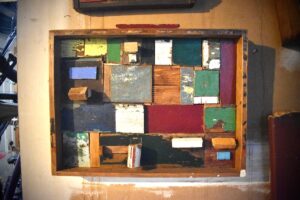
“There was a flood,” he says, caused by a broken pipe. “They had to cut out a piece of the wall. I turned around and I redid it, but I added a knob and I put a story on it. I was channeling Louise Nevelson” — who became famous in the 1960s for her cubist-influenced puzzle-like installations of scavenged materials.
On a workbench is a piece Catalano brought home from his Spiritus show last spring. “It didn’t sell,” he shrugs, “maybe because it didn’t have a monument in it.”
The sculpture is layered with horizontal fields fitted into an old drawer, the colors arrayed map-like: a lapis rectangle represents a pond or a pool; a raised white block is a house; there are rectangular green fields, red blocks for flowers, and rows representing raw earth. “I was trying to create what you’d see from an airplane,” he says. “It all comes down to a world contained in a drawer.”
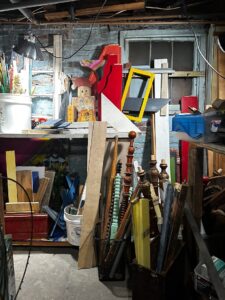
Apologizing for the television left on in one corner, Catalano heads to the back of the basement where there’s a trove of found objects and pieces of wood, some spray-painted with graffiti — finds from the dump and local swap shops. “I select them,” he says, but even though he’s particular about what he brings home, he admits he’s getting to the point where he’s overwhelmed by the possibilities they present. From time to time, he says, he invites other artists to take what they want.
“I wish I could say what creates what, or why something draws me to it and makes it into a piece of art,” Catalano says. “But I can’t answer that. I know when one piece is next to another and they belong together, even though they might have their own history. I somehow just know it.”



